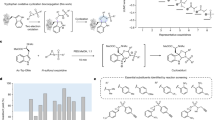Abstract
KARLIN and Bartels1 found that dithiothreitol (DTT) inhibits the responses induced by acetylcholine (ACh) in the Electrophorus electricus electroplax preparation and that 5,5′-dithio-bis-(2-nitrobenzoic acid) completely restored the membrane sensitivity to ACh. These results illustrate the importance of disulphide bonds for acetylcholine receptor (AChR) function, and work on other preparations with nicotinic AChRs gave similar results2–9. Several facts suggest that DTT affects AChRs specifically; (1), the significance of the quaternary ammonium group in the molecules of alkylating and acylating agents for the rate of their reaction with the AChR reduced by DTT10; (2) changes in pharmacological specificity seen in the modified receptor5,7,10;(3) the decrease in the slope of the dose–response curve to carbamylcholine expressed as the Hillplot11; and (4) the increase in d-tubocurarine affinity to the AChR active site5. If we could protect the receptor against chemical modification by an agonist or antagonist, this would be the most reliable proof of the specificity of modifying agent action12. We present here a detailed study of the action of DTT on nicotinic AChRs of completely isolated Limnaea stagnalis neurones in order to clarify the ability of various cholinergic ligands to protect the receptor disulphide bonds against reduction by DTT.
This is a preview of subscription content, access via your institution
Access options
Subscribe to this journal
Receive 51 print issues and online access
$199.00 per year
only $3.90 per issue
Buy this article
- Purchase on Springer Link
- Instant access to full article PDF
Prices may be subject to local taxes which are calculated during checkout
Similar content being viewed by others
References
Karlin, A. & Bartels, E. Biochim. biophys. Acta 126, 525–535 (1966).
Albuquerque, E. X., Sokoll, M. D., Sonesson, B. & Thesleff, S. Eur. J. Pharmac. 4, 40–46 (1968).
Mittag, T. W. & Tormay, A. Fedn Proc. 29, 574 (1970).
Del Castillo, J., Escobar, I. & Gijon, E. Int. J. Neurosci. 1, 199–209 (1971).
Rang, H. P. & Ritter, J. M. Molec. Pharmac. 7, 620–631 (1971).
Eldefrawi, M. E. & Eldefrawi, A. T. Proc. natn. Acad. Sci. U.S.A. 69, 1776–1780 (1972).
Ross, D. H. & Triggle, D. J. Biochem. Pharmac. 21, 2533–2536 (1972).
Ben-Haim, D., Landau, E. M. & Silman, I. J. Physiol. Lond. 234, 305–325 (1973).
Sato, T., Sato, M. & Sawada, M. Jap. J. Physiol. 26, 471–485 (1976).
Karlin, A. & Winnik, M. Proc. natn. Acad. Sci. U.S.A. 60, 668–674 (1968).
Karlin, A. J. theoret. Biol. 16, 306–320 (1967).
Singer, S. J. Adv. Protein Chem. 22, 1–54 (1967).
Kostenko, M. A. Cytologia 14, 1274–1279 (1 2).
Kostenko, M. A., Geletyuk, V. I. & Veprintsev, B. N. Comp. Biochem. Physiol. 49A, 89–100 (1974).
Silman, I. & Karlin, A. Science 164, 1420–1421 (1969).
Schimerlik, M. & Raftery, M. A. Biochem. biophys. Res. Commun. 73, 607–613 (1976).
Grünhagen, H. H. & Changeux, J.-P. J. molec. Biol. 106, 517–535 (1976).
Bregestovski, P. D., Vulfius, C. A. & Veprintsev, B. N. in Acetylcholine Receptor Function and the Structure of its Active Site 113–139 (Pushchino, 1975).
Bartels, E., Deal, W., Karlin, A. & Mautner, H. Biochim. biophys. Acta 203, 568–571 (1970).
Author information
Authors and Affiliations
Rights and permissions
About this article
Cite this article
BREGESTOVSKI, P., ILJIN, V., JURCHENKO, O. et al. Acetylcholine receptor conformational transition on excitation masks disulphide bonds against reduction. Nature 270, 71–73 (1977). https://doi.org/10.1038/270071a0
Received:
Accepted:
Issue Date:
DOI: https://doi.org/10.1038/270071a0
This article is cited by
-
Changes in channel properties of acetylcholine receptors during the time course of thiol chemical modifications
Pfl�gers Archiv European Journal of Physiology (1991)
-
Sulphonation of cholinergic receptor disulphide bond increases response to ACh
Nature (1979)
-
Activation of the frog sartorius acetylcholine receptor by a covalently attached group
The Journal of Membrane Biology (1979)
Comments
By submitting a comment you agree to abide by our Terms and Community Guidelines. If you find something abusive or that does not comply with our terms or guidelines please flag it as inappropriate.



